Multisport-Integrated Training for Rugby Instructors: Success and Effects on Minirugby Players
Abstract
1. Introduction
- Setting: The methodological organization/structure of the minirugby program, the structure of the rugby club, and the broader structure of the community in which the club is embedded.
- Activities: Practicing the sport of interest, considering other physical/sports activities in different contexts, and engaging in complementary socio-cultural activities (school, art, music).
- Social dynamics: Within the specific sports context (instructor-child, child-child, and parent-child relationships), within complementary sports activities and group dynamics (interdependence, cohesion, identity), and within the socio-cultural sphere (external relationships with public and private entities).
- Theoretical reference training (in this case, model-integrated and multisport information).
- Proactive workshop formula, focusing on sharing, deciding and formulating teaching objectives, discussing these with the learners and reflecting on didactic-methodological decisions.
- Organization of traineeships (congruent with the knowledge of the theoretical topics covered) with proposals to be formulated by teachers for their colleagues and to children from different sports categories.
- Analysis of the effects of the training proposal on teachers’ teaching ability and of the transference that these effects present on the motor competence, enjoyment, perception of self-efficacy; amount of physical-motor commitment of the children attending the courses in which these instructors carry out their educational activities.
- Evaluation of instructors’ satisfaction with the training course.
- Comparison of the effects of this training with those of youth sports instructors who follow the sports federations’ standard, predominantly sport-specific and technical training.
2. Materials and Methods
2.1. Study Design
2.2. Participants
2.3. Procedure
2.4. The Multisport Instructor Training Course for IAC
- Four meetings of 6 h and 15 min per meeting (25 h total—1 University Training Credit);
- A theoretical part in the classroom (2 h 15 min) structured with the following criterion: theory integrated with the subsequent practice of the internship (30/40 min); group work with discussions on the theoretical topics covered (15/20 min); questions from group work (a person in charge collects the requests for clarification that emerged from the previous discussion and addresses them to the trainers, 10 min); preparatory theory for the development of practical lessons (30/40 min); group work aimed at preparing internship interventions (themed lessons and methodological organization of the teaching moment, 15/20 min); questions from group work requesting further clarification on the internship (10 min);
- A practical part on the field, training with the coaches with an alternation in the roles of instructor, student, and observer (2 h);
- A practical part on the field, training with children with instructors who alternate in leading the lessons and observing (2 h).
- Proposal to rugby instructors with previous technical-sporting experience on which to base further knowledge and teaching-training strategies, in particular through multisport activities (basketball, ultimate, mini-volleyball, peteca, judo) valid for a specific transfer into the discipline;
- Sufficient duration of the experimentation (six months) and support to the instructors by the trainers, in the classroom and the field, to guarantee the learning and consolidation of the new skills;
- Composition of the team of trainers (scientific coordinator, teaching coordinator, researchers, doctoral students, and graduate students specially trained in administering questionnaires, motor tests, video recording, and analysis).
- Satisfaction of the instructors with the program received, highlighting strengths and weaknesses;
- Learning of knowledge, with greater awareness of the educational aspects of the multisport, of the teaching styles that can be used and their effects, of the languages that can be used in communication on the field and the gym through the acquisition of an expressive, empathetic and engaging them;
- Modification of teaching behavior during internship experiences with coaches and children (ability to use different teaching styles and more effective educational communication; improvement of one’s teaching-organizational skills);
- Final results achieved (benefits acquired by the children who follow the multisport rugby introductory courses and determined by the educational training process followed by the instructors).
2.5. Measures
- Internship evaluation sheet in physical education and sports (IESPES) modified by Navickiene [26]: It is a tool designed with the aim of measuring the different didactic competencies acquired during training with real practice in the field highlighted in the application context of the internship on children or colleagues involved in the training [22,27]. A score from one to five points is attributed to communication capacity, didactics organization, and capacity of motivation and to engage the pupils [28]. The descriptors of the modified IESPES are detailed in the Appendix A;
- The teaching styles questionnaire (TSQ) [29,30]: It is designed to assess the instructors’ perception of their teaching styles. It is composed of eleven items based on Mosston and Ashworth’s spectrum of teaching styles scored by a 5-point Likert scale corresponding to the frequency of each style occurrence [31];
- The questionnaire of satisfaction (QS) by Kirkpatrick and Kirkpatrick [22]: It is a tool designed to measure the level of satisfaction of participants in the training course. The training program is considered satisfactory if the participating instructors are happy with it and motivated to learn. Participants’ interest, attention and motivation to attend the course are indicators of the program’s appreciation. The questionnaire is scored by a four-point Likert scale and includes thirteen questions. The questionnaire showed a good internal consistency equal to a Cronbach alpha value of 0.836.
- Körperkoordinationtest für Kinder (KTK) [34] is a product test that measures coordination skills. The KTK consists of four items; a final score can be obtained for each test. The scores are added and converted with the reference nomograms by age and gender, returning a motor quotient indicating the level of body mastery possessed by the subject.
- The Physical Activity Questionnaire for Older Children (PAQ-C) [35] aims to determine the level of physical activity in the last 7 days, including sports, recreational activities, dancing, climbing, cycling, and unstructured activities. Low scores (from 1 to 2.33) correspond to a low level, medium scores indicate a moderate level (from 2.34 to 3.66), and high scores (from 3.67 to 5.00) imply a high level of physical activity;
- The game performance assessment instrument (GPAI) [36] aims to evaluate game performance behaviors that demonstrate tactical understanding and the player’s ability to solve tactical problems by selecting and applying appropriate skills. Our study used it as the overall game performance of the whole team. To the different variables of the game (decision making, skills execution, support, game performance), judgments of appropriate/inappropriate and efficient/inefficient responses were given using percentages of total responses. A score is attributed based on an overall division between the number of appropriate versus inappropriate responses, and a score over one indicates more positive than non-positive responses. The GPAI video analyses were performed before and after the intervention.
- The Physical Activity Enjoyment Scale (PACES) [37] is a 16-item questionnaire validated for elementary school students from 12 to 16 years old. PACES scores the items answers based on a 5-point Likert scale (1: completely disagree, 2: disagree, 3: uncertain, 4: agree, 5: fully agree);
- The physical self-efficacy scale for children (PSES) [38] evaluates one’s self-perception of one’s physical efficiency in motor skills. This is considered a primary motivation for voluntary physical activity and sports participation. The test is scored 1–24. The higher the score, the higher the self-efficacy.
2.6. Statistical Analysis
3. Results
Mediation and Moderation Analysis
4. Discussion
Limits of This Study
5. Conclusions
Author Contributions
Funding
Institutional Review Board Statement
Informed Consent Statement
Data Availability Statement
Conflicts of Interest
Appendix A. IESPES Items’ Descriptors
| Items | Descriptors 1 |
|---|---|
| Verbal communication | Comprehension; logic; choice of words of appreciation; choice of words of reproach; use of metaphors/narration. |
| Voice and paralanguage | Volume; Timbre; Modulation; expository rhythm; use of silences and pauses. |
| Non-verbal communication | Facial expression; eye gaze; eye contact; posture; proxemics gestures. |
| Specific didactics | Choice of exercises; progression; demonstration; correction; adaptation of the proposal. |
| Elements of organizational references | Location of tools; location in space of learners; safety/prevention/assistance rules; use of conceptual diagrams/charts/illustrations; time management (activity times; question times; organizational times). |
| Psychological references | Interest aroused; emulation level; expectations/requests; reinforcement; contextualization. |
| Personal competence | Charisma; accuracy; confidence; empathy; self-monitoring |
References
- Arango-Paternina, C.M.; Watts-Fernández, W.J.; Brownson, R. Pensamiento complejo y sistémico en educación física y promoción de actividad física. Educ. Física Deporte 2022, 41, 81–105. [Google Scholar] [CrossRef]
- Bronfenbrenner, U. Toward an Experimental Ecology of Human Development. Am. Psychol. 1977, 32, 513–531. [Google Scholar] [CrossRef]
- Coté, J.; Turnnidge, J.; Murata, A.; Mcguire, C.S.; Martin, L.J. Youth sport research: Describing the integrated dynamic elements of the personal assets framework. Int. J. Sport Psychol. 2020, 51, 562–578. [Google Scholar] [CrossRef]
- Coté, J.; Strachan, L.; Fraser-Thomas, J. Participation, personal development, and performance through youth sport. In Positive Youth Development Through Sport; Routledge: London, UK, 2008. [Google Scholar]
- Rigon, M.; Signorini, G.; Scurati, R.; Trecroci, A.; Colella, D.; Formenti, D.; Merati, G.; Cherubini, D.; Invernizzi, P.L. Relationship Between Multi-Teaching Styles and Didactics Effectiveness on Rugby Instructors and Minirugby Players. Children 2024, 11, 1319. [Google Scholar] [CrossRef] [PubMed]
- Storey, B.; Butler, J. Complexity thinking in PE: Game-centred approaches, games as complex adaptive systems, and ecological values. Phys. Educ. Sport Pedagog. 2012, 18, 133–149. [Google Scholar] [CrossRef]
- D.P.R. 28/3 n. 80. Regolamento sul Sistema Nazionale di Valutazione in Materia di Istruzione e Formazione; Ministero dell’Istruzione e del Merito: Roma, Italy, 2013.
- Legge 26 Settembre n. 197. Modifica All’articolo 33 Della Costituzione; Parlamento Italiano: Rome, Italy, 2023.
- Pill, S.; SueSee, B.; Davies, M. The Spectrum of Teaching Styles and models-based practice for physical education. Eur. Phys. Educ. Rev. 2024, 30, 142–155. [Google Scholar] [CrossRef]
- Coalter, F. Sport-for-Change: Some Thoughts from a Sceptic. Soc. Incl. 2015, 3, 19. [Google Scholar] [CrossRef]
- Coalter, F. Sport and Social Inclusion: Evidence-Based Policy and Practice. Soc. Incl. 2017, 5, 141–149. [Google Scholar] [CrossRef]
- Hartmann, D. Theorizing Sport as Social Intervention: A View From the Grassroots. Quest 2003, 55, 118–140. [Google Scholar] [CrossRef]
- Sebire, S.J.; Jago, R.; Fox, K.R.; Edwards, M.J.; Thompson, J.L. Testing a self-determination theory model of children’s physical activity motivation: A cross-sectional study. Int. J. Behav. Nutr. Phys. Act. 2013, 10, 111. [Google Scholar] [CrossRef]
- Ntoumanis, N.; Quested, E.; Reeve, J.; Cheon, S.H. Need-supportive communication: Implications for motivation in sport, exercise, and physical activity. In Persuasion and Communication in Sport, Exercise, and Physical Activity; Routledge: Abingdon, UK, 2017; pp. 155–169. [Google Scholar]
- Asún-Dieste, S.; Romero-Martín, M.R.; Aparicio-Herguedas, J.L.; Fraile-Aranda, A. Proxemic Behaviour in Pre-service Teacher Training in Physical Education. Apunt. Educ. Física Deportes 2020, 3, 41–48. [Google Scholar] [CrossRef]
- Jovanovic, M.; Zdravković, D. Nonverbal communication and physical education classes in a social context. Facta Universitatis. Ser. Phys. Educ. Sport 2017, 15, 195–206. [Google Scholar] [CrossRef]
- Kirk, D. Physical education, youth sport and lifelong participation: The importance of early learning experiences. Eur. Phys. Educ. Rev. 2005, 11, 239–255. [Google Scholar] [CrossRef]
- Pesce, C.; Faigenbaum, A.; Crova, C.; Marchetti, R.; Bellucci, M. Benefits of multi-sports physical education in the elementary school context. Health Educ. J. 2012, 72, 326–336. [Google Scholar] [CrossRef]
- Fortier, M.S.; Duda, J.L.; Guerin, E.; Teixeira, P.J. Promoting physical activity: Development and testing of self-determination theory-based interventions. Int. J. Behav. Nutr. Phys. Act. 2012, 9, 20. [Google Scholar] [CrossRef]
- Deci, E.L.; Ryan, R.M. The “What” and “Why” of Goal Pursuits: Human Needs and the Self-Determination of Behavior. Psychol. Inq. 2000, 11, 227–268. [Google Scholar] [CrossRef]
- McKenney, S.; Schunn, C.D. How can educational research support practice at scale? Attending to educational designer needs. Br. Educ. Res. J. 2018, 44, 1084–1100. [Google Scholar] [CrossRef]
- Kirkpatrick, D.L.; Kirkpatrick, J.D. Evaluating Training Programs, 3rd ed.; Berrett-Koehler Publishers: San Francisco, CA, USA, 2006. [Google Scholar]
- Harvey, S.; Jarrett, K. A review of the game-centred approaches to teaching and coaching literature since 2006. Phys. Educ. Sport Pedagog. 2014, 19, 278–300. [Google Scholar] [CrossRef]
- Sgrò, F.; Lipoma, M. Riflessioni sull’utilizzo dei Tactical Games Model nella scuola primaria. Form. Insegn. 2019, 17, 193–205. [Google Scholar] [CrossRef]
- Invernizzi, P.L.; Rigon, M.; Signorini, G.; Cherubini, D.; Scurati, R. Analysis of a Multi-Sport Educational Process for Sustainable Sports Education. Form. Insegn. 2024, 22, 7027. [Google Scholar]
- Navickienė, V.; Sederevičiūtė-Pačiauskienė, Ž.; Valantinaitė, I.; Žilinskaitė-Vytienė, V. The relationship between communication and education through the creative personality of the teacher. Creat. Stud. 2019, 12, 49–60. [Google Scholar] [CrossRef]
- Dewi, L.R.; Kartowagiran, B. An evaluation of internship program by using Kirkpatrick evaluation model. Res. Eval. Educ. 2018, 4, 155–163. [Google Scholar] [CrossRef]
- Molina-Moreno, P.; Molero-Jurado, M.d.M.; Pérez-Fuentes, M.d.C.; Gázquez-Linares, J.J. Analysis of personal competences in teachers: A systematic review. Front. Educ. 2024, 9, 1433908. [Google Scholar] [CrossRef]
- SueSee, B.; Edwards, K.; Pill, S.; Cuddihy, T. Self-reported teaching styles of Australian senior physical education teachers. Curr. Perspect. 2018, 38, 41–54. [Google Scholar] [CrossRef]
- Cothran, D.J.; Hodges Kulinna, P.; Banville, D.; Choi, E.; Amade-Escot, C.; MacPhail, A.; Macdonald, D.; Richard, J.F.; Sarmento, P.; Kirk, D. A cross-cultural investigation of the use of teaching styles. Res. Q. Exerc. Sport 2005, 76, 193–201. [Google Scholar] [CrossRef]
- Mosston, M.; Ashworth, S. Teaching Physical Education, 1st ed. Online Edition. 2008. Available online: https://spectrumofteachingstyles.org/assets/files/book/Teaching_Physical_Edu_1st_Online.pdf (accessed on 23 December 2024).
- Curtner-Smith, M.D. Instrument for Identifying Teaching Styles (IFITS). Available online: https://spectrumofteachingstyles.org/assets/files/articles/CurtnerSmith2001_IFITS.pdf (accessed on 27 October 2024).
- McKenzie, T.L.; Sallis, J.F.; Nader, P.R. SOFIT: System for Observing Fitness Instruction Time. J. Teach. Phys. Educ. 1992, 11, 195–205. [Google Scholar] [CrossRef]
- Kiphard, E.J.; Schilling, F. Körperkoordinationstest für Kinder KTK: Manual; Beltz Test: Weinheim, Germany, 1974. [Google Scholar]
- Crocker, P.R.; Bailey, D.A.; Faulkner, R.A.; Kowalski, K.C.; McGrath, R. Measuring general levels of physical activity: Preliminary evidence for the Physical Activity Questionnaire for Older Children. Med. Sci. Sports Exerc. 1997, 29, 1344–1349. [Google Scholar] [CrossRef]
- Oslin, J.L.; Mitchell, S.A.; Griffin, L.L. The Game Performance Assessment Instrument (GPAI): Development and preliminary validation. J. Teach. Phys. Educ. 1998, 17, 231–243. [Google Scholar] [CrossRef]
- Moore, J.B.; Yin, Z.; Hanes, J.; Duda, J.; Gutin, B.; Barbeau, P. Measuring Enjoyment of Physical Activity in Children: Validation of the Physical Activity Enjoyment Scale. J. Appl. Sport Psychol. 2009, 21, S116–S129. [Google Scholar] [CrossRef]
- Colella, D.; Morano, M.; Bortoli, L.; Robazza, C. A Physical Self-Efficacy Scale for Children. Soc. Behav. Pers. 2008, 36, 841–848. [Google Scholar] [CrossRef]
- Silva, B.V.F.d.; Santos, R.H.d.; Savarezzi, G.R.; Souza, M.T.d.; Gimenez, R. Teaching strategies in physical education: A confrontation between directive and indirective styles in volleyball learning. J. Phys. Educ. 2020, 31, e3168. [Google Scholar] [CrossRef]
- Bechter, B.E.; Dimmock, J.A.; Jackson, B. A cluster-randomized controlled trial to improve student experiences in physical education: Results of a student-centered learning intervention with high school teachers. Psychol. Sport Exerc. 2019, 45, 101553. [Google Scholar] [CrossRef]
- Mesquita, I.; Farias, C.; Hastie, P. The impact of a hybrid Sport Education–Invasion Games Competence Model soccer unit on students’ decision making, skill execution and overall game performance. Eur. Phys. Educ. Rev. 2012, 18, 205–219. [Google Scholar] [CrossRef]
- Deci, E.L.; Ryan, R.M. Self-Determination. In The Corsini Encyclopedia of Psychology; Weiner, I.B., Craighead, W.E., Eds.; John Wiley & Sons, Inc.: New York, NY, USA, 2010. [Google Scholar]
- Ryan, R.M.; Deci, E.L. Self-determination theory and the facilitation of intrinsic motivation, social development, and well-being. Am. Psychol. 2000, 55, 68–78. [Google Scholar] [CrossRef] [PubMed]
- Faigenbaum, A.D.; Kraemer, W.J.; Blimkie, C.J.; Jeffreys, I.; Micheli, L.J.; Nitka, M.; Rowland, T.W. Youth resistance training: Updated position statement paper from the national strength and conditioning association. J. Strength Cond. Res. 2009, 23, S60–S79. [Google Scholar] [CrossRef]
- Telama, R. Tracking of physical activity from childhood to adulthood: A review. Obes. Facts 2009, 2, 187–195. [Google Scholar] [CrossRef]
- Brian, A.; Getchell, N.; True, L.; De Meester, A.; Stodden, D.F. Reconceptualizing and Operationalizing Seefeldt’s Proficiency Barrier: Applications and Future Directions. Sports Med. 2020, 50, 1889–1900. [Google Scholar] [CrossRef]
- Popović, B.; Gušić, M.; Radanović, D.; Andrašić, S.; Madić, D.M.; Mačak, D.; Stupar, D.; Đukić, G.; Grujičić, D.; Trajković, N. Evaluation of Gross Motor Coordination and Physical Fitness in Children: Comparison between Soccer and Multisport Activities. Int. J. Environ. Res. Public Health 2020, 17, 5902. [Google Scholar] [CrossRef]
- Stankovic, D.; Horvatin, M.; Vlasic, J.; Pekas, D.; Trajkovic, N. Motor Coordination in Children: A Comparison between Children Engaged in Multisport Activities and Swimming. Sports 2023, 11, 139. [Google Scholar] [CrossRef] [PubMed]
- Condit, J.; Caballero, M.; Papanek, P.E. A Pilot Study to Analyze a Multisport/triathlon Program as a Mechanism to Promote Self-Determined Exercise among an Overweight Inner-City Middle School Latino Population. Int. J. Child Adolesc. Health 2015, 8, 497. [Google Scholar]
- Invernizzi, P.; Crotti, M.; Bosio, A.; Cavaggioni, L.; Alberti, G.; Scurati, R. Multi-Teaching Styles Approach and Active Reflection: Effectiveness in Improving Fitness Level, Motor Competence, Enjoyment, Amount of Physical Activity, and Effects on the Perception of Physical Education Lessons in Primary School Children. Sustainability 2019, 11, 405. [Google Scholar] [CrossRef]
- Luukkainen, N.M.; Laukkanen, A.; Niemistö, D.; Kotkajuuri, J.; Meklin, E.; Sääkslahti, A. Longitudinal relationship between organised and non-organised physical activities and overall physical activity in children aged 3–11 years. Eur. J. Sport Sci. 2024, 24, 1197–1206. [Google Scholar] [CrossRef] [PubMed]
- Moynihan, Ú.; McMahon, T. An Investigation of the Youth Development Effects of a School-based Multi-sport Initiative for First-year Boys. Int. J. Sport Soc. 2014, 4, 33–45. [Google Scholar] [CrossRef]
- Stodden, D.F.; Goodway, J.D.; Langendorfer, S.J.; Roberton, M.A.; Rudisill, M.E.; Garcia, C.; Garcia, L.E. A Developmental Perspective on the Role of Motor Skill Competence in Physical Activity: An Emergent Relationship. Quest 2008, 60, 290–306. [Google Scholar] [CrossRef]
- Crouch, K.L.; Larson, A.J.; DeBeliso, M. Motivation Differences between Youth Single-Sport, Multi-Sport, and Single-Sport Specialized Athletes in the Western United States. Athens J. Sports 2022, 9, 37–50. [Google Scholar] [CrossRef]
- Gardner, L.A.; Magee, C.A.; Vella, S.A. Enjoyment and Behavioral Intention Predict Organized Youth Sport Participation and Dropout. J. Phys. Act. Health 2017, 14, 861–865. [Google Scholar] [CrossRef]
- MacIntosh, E.; Kinoshita, K.; Naraine, M.; Sato, S. Examining the Youth Multi-Sport Event Environment: Implications towards athlete development and transitioning. J. Athl. Dev. Exp. 2019, 1, 1. [Google Scholar] [CrossRef]
- Condello, G.; Mazzoli, E.; Masci, I.; De Fano, A.; Ben-Soussan, T.D.; Marchetti, R.; Pesce, C. Fostering Holistic Development with a Designed Multisport Intervention in Physical Education: A Class-Randomized Cross-Over Trial. Int. J. Environ. Res. Public Health 2021, 18, 9871. [Google Scholar] [CrossRef]
- Baker, J. Early specialization in youth sport: A requirement for adult expertise? High Abil. Stud. 2003, 14, 85–94. [Google Scholar] [CrossRef]
- Malina, R.M. Early sport specialization: Roots, effectiveness, risks. Curr. Sports Med. Rep. 2010, 9, 364–371. [Google Scholar] [CrossRef]
- Hardman, K. School physical education and sport in europe-rhetoric and reality: Current and future perspectives. Kinesiology 2003, 35, 97–107. [Google Scholar]
- Hardman, K. Trends in physical education and society: Challenges for the physical education profession. In Proceedings of the “Science and Profession–Challenge for the Future”. 4th International Scientific Conference on Kinesiology, Opatija, Croatia, 7–11 September 2005; pp. 9–17. [Google Scholar]
- Invernizzi, P.L.; Signorini, G.; Rigon, M.; Larion, A.; Raiola, G.; D’Elia, F.; Bosio, A.; Scurati, R. Promoting Children’s Psychomotor Development with Multi-Teaching Didactics. Int. J. Environ. Res. Public Health 2022, 19, 10939. [Google Scholar] [CrossRef]
- Jaakkola, T.; Digelidis, N. Establishing a positive motivational climate in physical education. In Psychology for Physical Educators: Student in Focus, 2nd ed.; Human Kinetics: Champaign, IL, USA, 2007; pp. 3–20. [Google Scholar]
- Moy, B.; Renshaw, I.; Davids, K. The impact of nonlinear pedagogy on physical education teacher education students’ intrinsic motivation. Phys. Educ. Sport Pedagog. 2016, 21, 517–538. [Google Scholar] [CrossRef]
- Vygotsky, L.S. Thought and Language, Revised and Expanded Edition; MIT Press Ltd.: Cambridge, MA, USA, 2012. [Google Scholar]
- David, P. Human Rights in Youth Sport: A Critical Review of Children’s Rights in Competitive Sport, 1st ed.; Routledge: London, UK, 2004. [Google Scholar]
- Lang, M. Advancing children’s rights in sport: Coaching, childhood agency and the participatory agenda. Sports Coach. Rev. 2022, 11, 41–63. [Google Scholar] [CrossRef]
- Montesano, P.; Domenico, T.; Mazzeo, F. The drop-outs in young players. J. Phys. Educ. Sport 2016, 16, 1242–1246. [Google Scholar]
- Robbins, L.B.; Ling, J.; Chang, M.W. Organized Physical Activity Program Participation, Physical Activity, and Related Psychosocial Factors Among Urban Adolescents. J. Sch. Nurs. 2023, 39, 475–486. [Google Scholar] [CrossRef] [PubMed]
- Rigon, M.; Invernizzi, P.L.; Signorini, G.; Trecroci, A.; Scurati, R.; Formenti, D.; Colella, D.; Bosio, A.; Cherubini, D. The “thinking system” in a new school concept: A rhythmic teaching approach in physical education to develop creativity. PLoS ONE 2024, 19, e0301858. [Google Scholar] [CrossRef] [PubMed]
- Berger, K. The Developing Person Through the Life Span; Worth Publishers: New York, NY, USA, 2005. [Google Scholar]
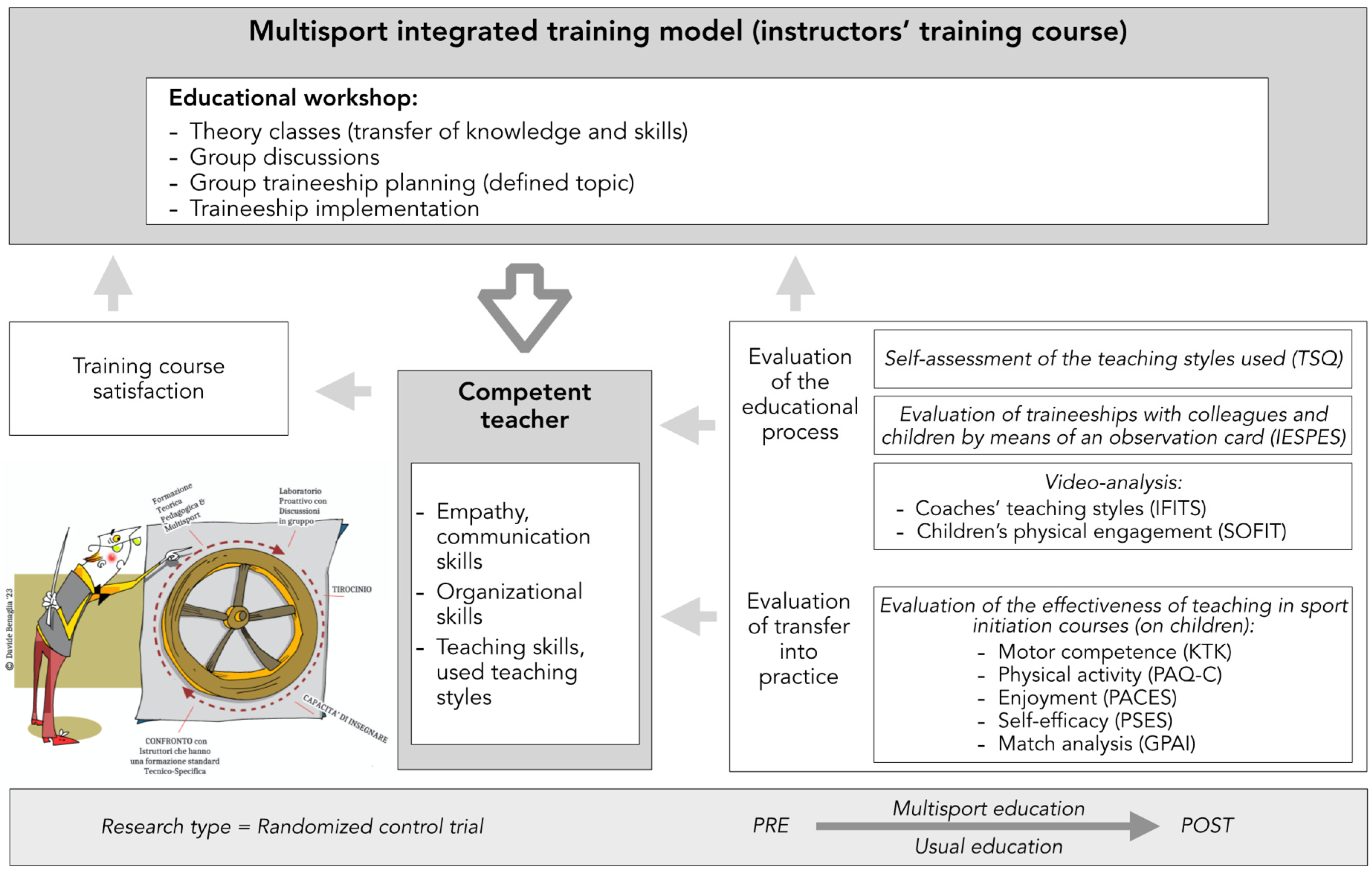
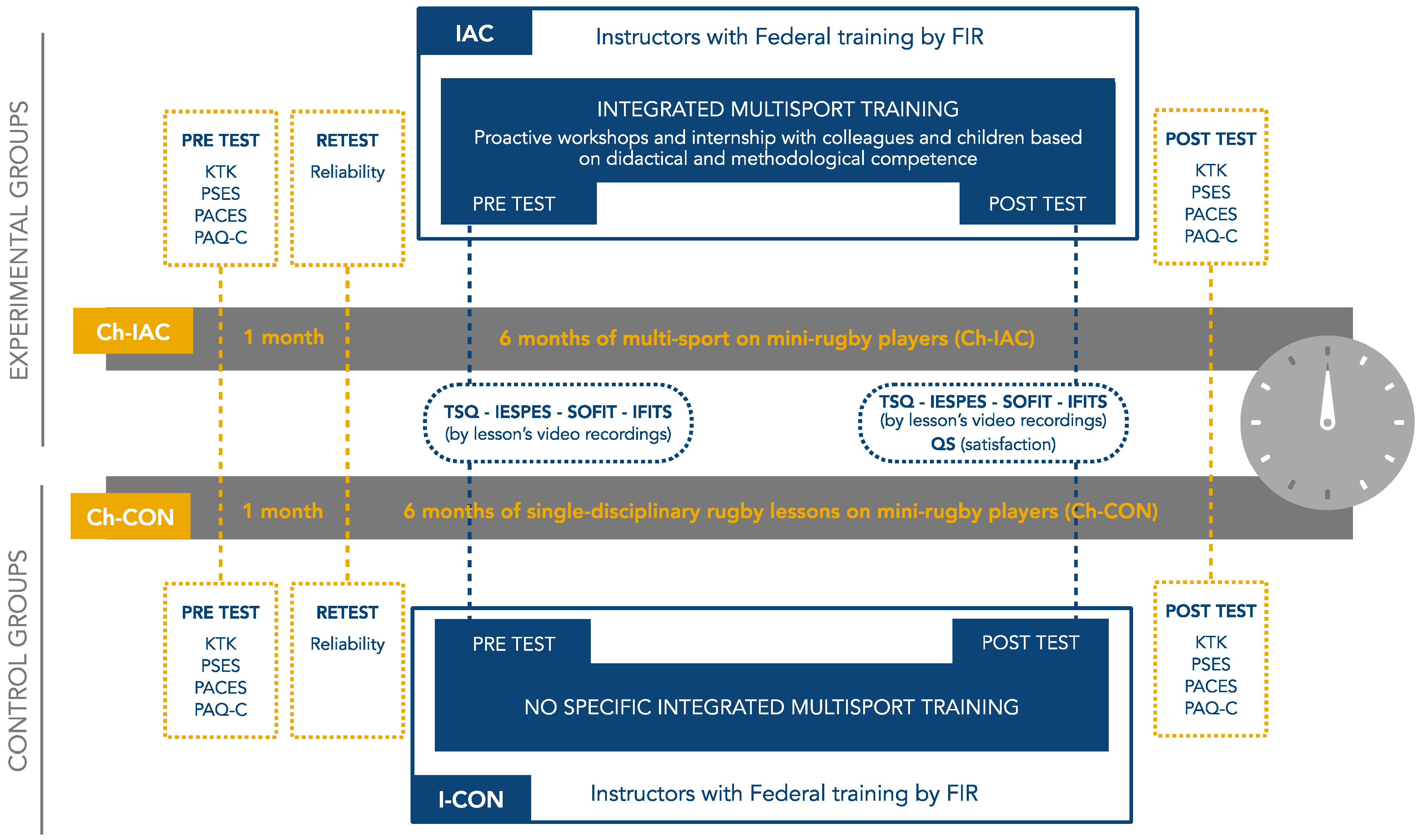
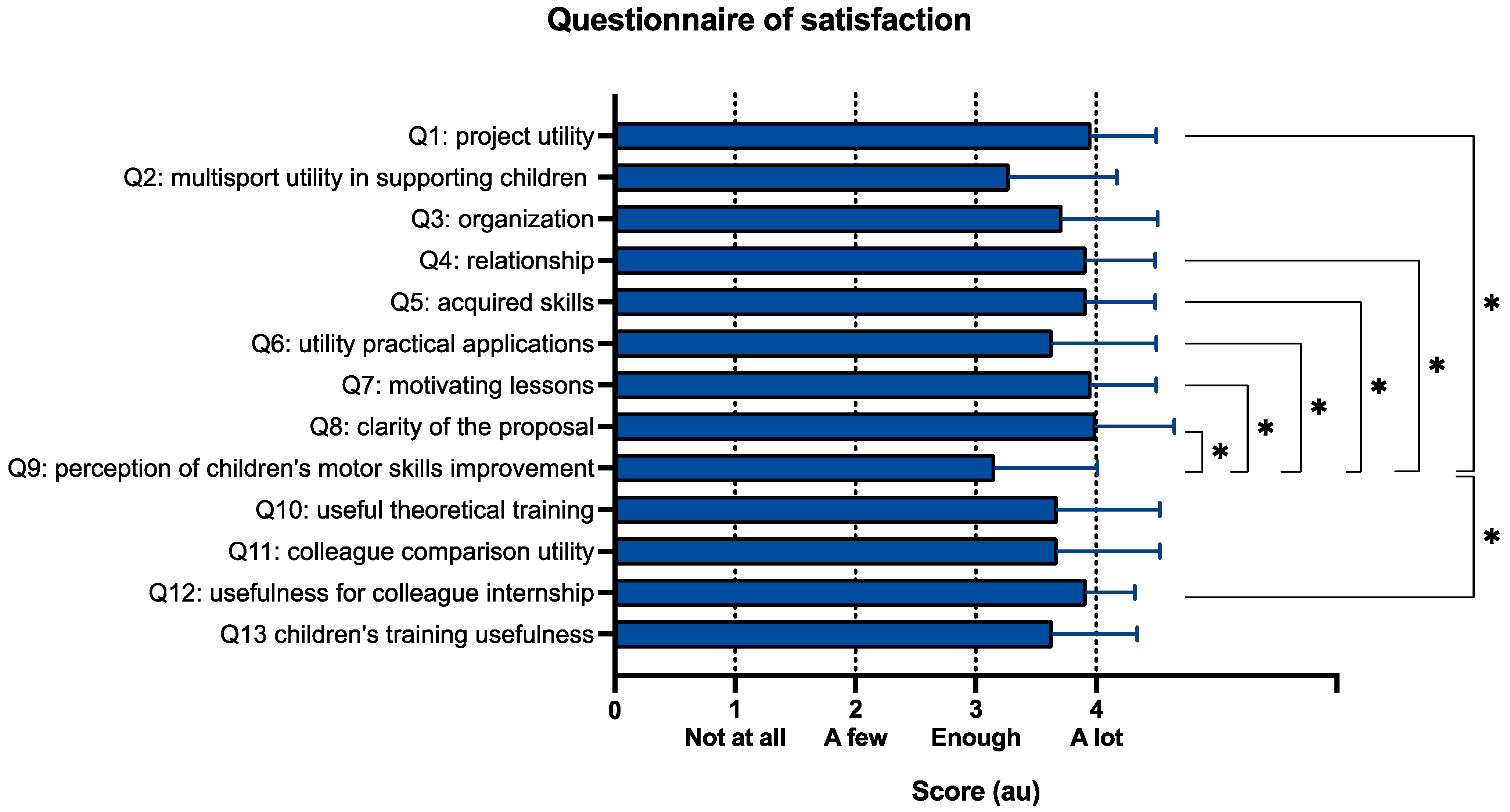




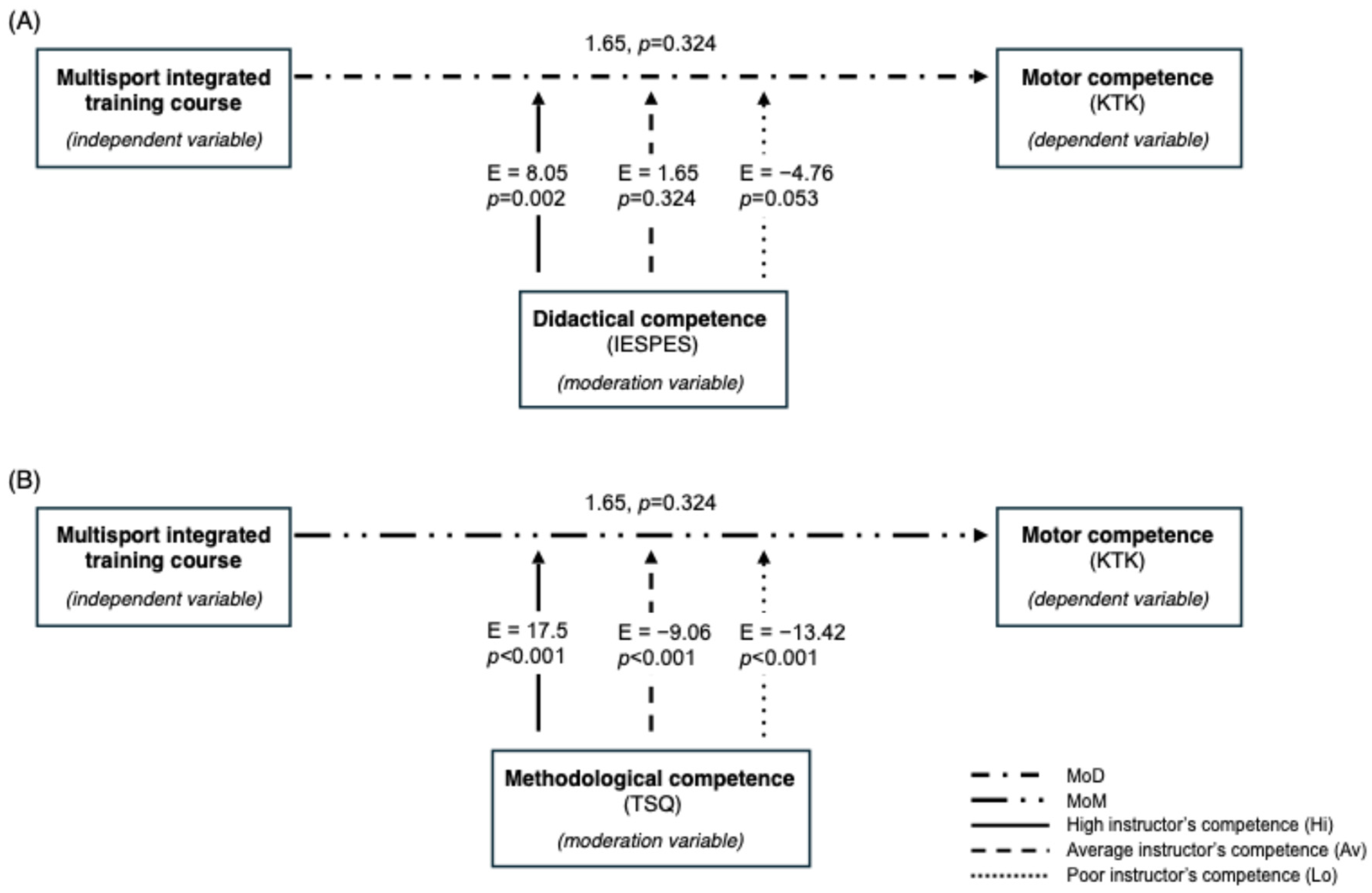
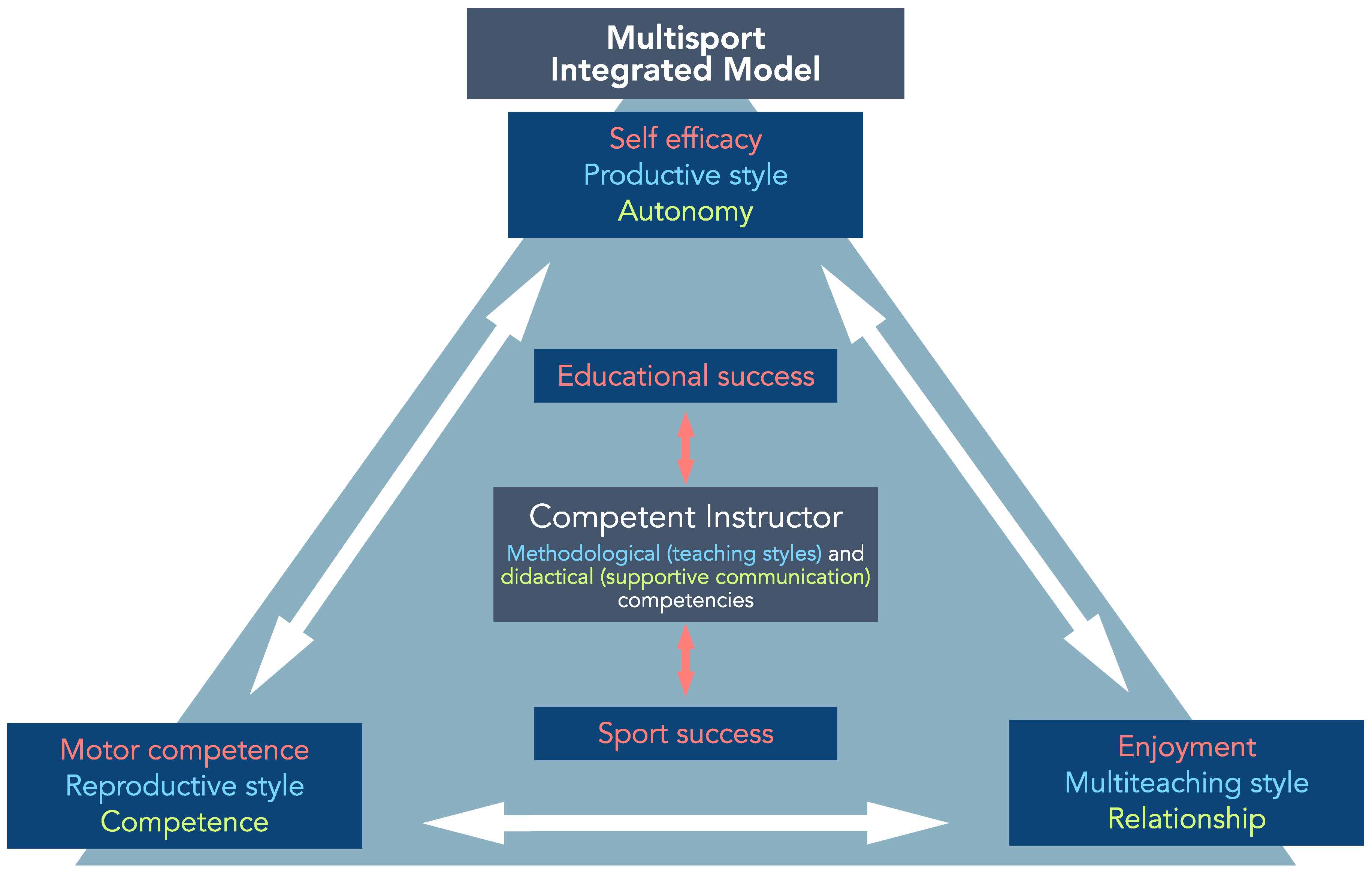
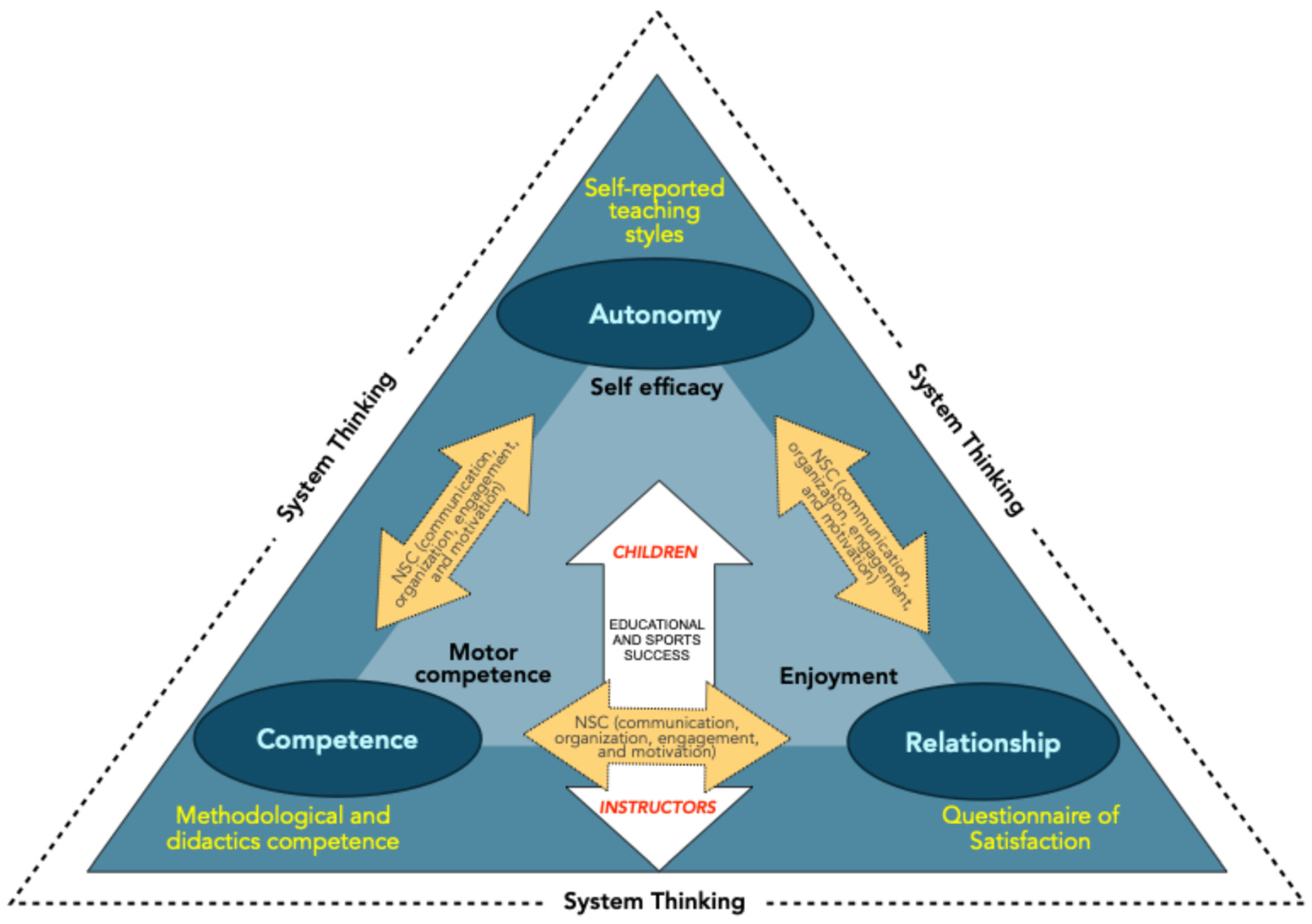
| Participants | Variable | Experimental (IAC, Ch-IAC) | Control (CON, Ch-CON) |
|---|---|---|---|
| Instructors | N | 25 (21 m, 4 f) | 25 (24 m, 1 f) |
| Age (y) | 36.2 ± 14.4 | 40.0 ± 12.8 | |
| Teaching experience (y) | 5.36 ± 6.0 | 7.0 ± 5.0 | |
| Children | N | 109 (106 m, 3 f) | 111 (110 m, 1 f) |
| Age (y) | 9.6 ± 1.1 | 9.6 ± 1.0 | |
| Weight (kg) | 36.5 ± 8.3 | 35.4± 6.5 | |
| Height (m) | 1.38 ± 0.07 | 1.39 ± 0.07 | |
| BMI (kg/m−2) | 19.1 ± 3.6 | 18.2 ± 2.8 |
| IESPES Parameters | Time Point | IAC | I-CON |
|---|---|---|---|
| Communication | Pre | 2.9 ± 0.7 | 3.1 ± 0.5 |
| Post | 3.7 ± 0.4 | 3.0 ± 0.5 | |
| ∆ (post–pre) | 0.8 ± 0.4 § | 0.0 ± 0.3 | |
| Didactics organization | Pre | 2.9 ± 0.7 | 3.0 ± 0.8 |
| Post | 3.7 ± 0.7 | 3.2 ± 0.6 | |
| ∆ (post–pre) | 0.8 ± 0.6 § | 0.2 ± 0.5 | |
| Motivation and personal competence | Pre | 2.4 ± 0.7 | 2.6 ± 0.7 |
| Post | 3.6 ± 0.4 | 2.6 ± 0.7 | |
| ∆ (post–pre) | 1.1 ± 0.6 § | 0.1 ± 0.5 | |
| Total mean score | Pre | 2.8 ± 0.5 | 2.9 ± 0.3 |
| Post | 3.7 ± 0.3 | 3.0 ± 0.4 | |
| ∆ (post–pre) | 0.9 ± 0.3 § | 0.1 ± 0.2 |
| Teaching Style | Time Point | IAC | I-CON |
|---|---|---|---|
| Multi-teaching | Pre | 3.5 ± 1.2 * | 2.9 ± 0.8 |
| Post | 4.8 ± 1.3 * | 2.7 ± 0.8 | |
| ∆ (post–pre) | 1.3 ± 0.9 * | −0.2 ± 0.5 | |
| Reproduction | Pre | 2.6 ± 0.6 * | 2.2 ± 0.5 |
| Post | 3.0 ± 0.8 * | 2.2 ± 0.5 | |
| ∆ (post–pre) | 0.4 ± 0.5 * | 0.0 ± 0.0 | |
| Production | Pre | 0.9 ± 0.9 | 0.6 ± 0.8 |
| Post | 1.8 ± 1.0 * | 0.4 ± 0.7 | |
| ∆ (post–pre) | 0.9 ± 0.8 * | −0.2 ± 0.5 |
| Teaching Style | Time Point | IAC | I-CON |
|---|---|---|---|
| Command | Pre | 23.3 ± 21.9 | 4.9 ± 8.8 |
| Post | 39.4 ± 13.6 * | 8.8 ± 15.8 | |
| ∆ (post–pre) | 16.0 ± 27.6 | 3.9 ± 13.2 | |
| Practice | Pre | 37.6 ± 28.0 * | 62.2 ± 24.6 |
| Post | 20.0 ± 10.0 * | 59.5 ± 21.2 | |
| ∆ (post–pre) | −17.0 ± 32.7 | −2.7 ± 13.4 | |
| Reciprocal | Pre | N/U | N/U |
| Post | 3.5 ± 6.9 | N/U | |
| ∆ (post–pre) | 3.5 ± 6.9 | N/A | |
| Self-check | Pre | N/U | N/U |
| Post | N/U | N/U | |
| ∆ (post–pre) | N/A | N/A | |
| Inclusion | Pre | N/U | N/U |
| Post | 8.2 ± 1.8 * | N/U | |
| ∆ (post–pre) | 8.2 ± 1.8 * | N/A | |
| Guided discovery | Pre | N/U | N/U |
| Post | 10.5 ± 9.3 * | N/U | |
| ∆ (post–pre) | 10.5 ± 9.3 * | N/A | |
| Convergent discovery | Pre | N/U | N/U |
| Post | N/U | N/U | |
| ∆ (post–pre) | N/A | N/A | |
| Going beyond | Pre | N/U | N/U |
| Post | N/U | N/U | |
| ∆ (post–pre) | N/A | N/A | |
| Management | Pre | 39.1 ± 11.3 | 32.9 ± 21.7 |
| Post | 19.4 ± 10.4 * | 31.7 ± 7.9 | |
| ∆ (post–pre) | −19.7 ± 17.3 * | −1.2 ± 17.3 | |
| Total Reproduction | Pre | 60.9 ± 11.3 | 67.1 ± 21.7 |
| Post | 70.9 ± 8.3 | 68.3 ± 7.9 | |
| ∆ (post–pre) | 10.1 ± 15.7 | 1.2 ± 17.3 | |
| Total Production | Pre | N/U | N/U |
| Post | 10.5 ± 9.3 * | N/U | |
| ∆ (post–pre) | 10.5 ± 9.3 * | N/A |
| Children’s Commitment | Time Point | IAC | I-CON | |
|---|---|---|---|---|
| Children’s activity | Lay | Pre | 1.2 ± 2.6 | 0.3 ± 0.9 |
| Post | 0.9 ± 1.4 | 0.4 ± 0.8 | ||
| ∆ (post–pre) | −0.3 ± 3.3 | 0.1 ± 1.3 | ||
| Seated | Pre | 3.1 ± 4.6 | 2.5 ± 3.6 | |
| Post | 4.3 ± 3.3 | 3.7 ± 3.0 | ||
| ∆ (post–pre) | 1.2 ± 4.4 | 1.2 ± 4.5 | ||
| Stand | Pre | 33.6 ± 16.3 | 26.6 ± 14.4 | |
| Post | 11.2 ± 5.6 * | 20.2 ± 12.3 | ||
| ∆ (post–pre) | −22.4 ± 20.4 | −6.4 ± 22.9 | ||
| Moderate | Pre | 25.1 ± 11.9 | 28.5 ± 11.6 | |
| Post | 34.8 ± 9.0 | 31.2 ± 11.1 | ||
| ∆ (post–pre) | 9.7 ± 15.1 | 2.8 ± 18.2 | ||
| Vigorous | Pre | 37.0 ± 14.1 | 43.2 ± 12.2 | |
| Post | 48.8 ± 10.2 | 44.4 ± 12.8 | ||
| ∆ (post–pre) | 11.9 ± 21.0 | 1.3 ± 18.7 | ||
| Lesson content | Management | Pre | 7.8 ± 3.6 | 6.4 ± 2.7 |
| Post | 2.6 ± 1.0 * | 7.5 ± 1.8 | ||
| ∆ (post–pre) | −5.1 ± 3.3 * | 1.1 ± 3.1 | ||
| Knowledge | Pre | 21.6 ± 9.0 | 21.2 ± 11.0 | |
| Post | 23.0 ± 7.1 | 17.9 ± 17.4 | ||
| ∆ (post–pre) | 1.4 ± 12.8 | −3.3 ± 20.9 | ||
| Fitness | Pre | 13.6 ± 19.2 | 19.7 ± 21.0 | |
| Post | 2.1 ± 4.0 * | 12.1 ± 9.4 | ||
| ∆ (post–pre) | −11.6 ± 18.0 | −7.6 ± 18.8 | ||
| Skills | Pre | 44.7 ± 26.2 | 39.7 ± 28.4 | |
| Post | 40.5 ± 12.5 | 31.4 ± 20.9 | ||
| ∆ (post–pre) | −4.2 ± 28.6 | −8.3 ± 30.1 | ||
| Game | Pre | 11.9 ± 15.7 | 13.0 ± 17.9 | |
| Post | 31.8 ± 11.4 * | 31.2 ± 32.9 | ||
| ∆ (post–pre) | 19.9 ± 16.5 | 18.2 ± 30.1 | ||
| Coaches’ interaction | Inside lesson topics | Pre | 38.5 ± 12.5 | 33.0 ± 12.4 |
| Post | 42.1 ± 11.8 | 38.0 ± 13.4 | ||
| ∆ (post–pre) | 3.6 ± 11.4 | 5.1 ± 9.4 | ||
| Outside lesson topics | Pre | 0.0 ± 0.0 | 0.0 ± 0.0 | |
| Post | 4.4 ± 3.2 * | 0.0 ± 0.0 | ||
| ∆ (post–pre) | 4.4 ± 3.2 | 0.0 ± 0.0 | ||
| No interaction | Pre | 61.3 ± 12.2 | 67.0 ± 12.4 | |
| Post | 54.6 ± 14.5 | 62.1 ± 13.3 | ||
| ∆ (post–pre) | −6.8 ± 13.0 | −5.0 ± 9.3 | ||
Disclaimer/Publisher’s Note: The statements, opinions and data contained in all publications are solely those of the individual author(s) and contributor(s) and not of MDPI and/or the editor(s). MDPI and/or the editor(s) disclaim responsibility for any injury to people or property resulting from any ideas, methods, instructions or products referred to in the content. |
© 2024 by the authors. Licensee MDPI, Basel, Switzerland. This article is an open access article distributed under the terms and conditions of the Creative Commons Attribution (CC BY) license (https://creativecommons.org/licenses/by/4.0/).
Share and Cite
Rigon, M.; Signorini, G.; Scurati, R.; Trecroci, A.; Colella, D.; Formenti, D.; Merati, G.; Cherubini, D.; Invernizzi, P.L. Multisport-Integrated Training for Rugby Instructors: Success and Effects on Minirugby Players. J. Funct. Morphol. Kinesiol. 2025, 10, 11. https://doi.org/10.3390/jfmk10010011
Rigon M, Signorini G, Scurati R, Trecroci A, Colella D, Formenti D, Merati G, Cherubini D, Invernizzi PL. Multisport-Integrated Training for Rugby Instructors: Success and Effects on Minirugby Players. Journal of Functional Morphology and Kinesiology. 2025; 10(1):11. https://doi.org/10.3390/jfmk10010011
Chicago/Turabian StyleRigon, Marta, Gabriele Signorini, Raffaele Scurati, Athos Trecroci, Dario Colella, Damiano Formenti, Giampiero Merati, Domenico Cherubini, and Pietro Luigi Invernizzi. 2025. "Multisport-Integrated Training for Rugby Instructors: Success and Effects on Minirugby Players" Journal of Functional Morphology and Kinesiology 10, no. 1: 11. https://doi.org/10.3390/jfmk10010011
APA StyleRigon, M., Signorini, G., Scurati, R., Trecroci, A., Colella, D., Formenti, D., Merati, G., Cherubini, D., & Invernizzi, P. L. (2025). Multisport-Integrated Training for Rugby Instructors: Success and Effects on Minirugby Players. Journal of Functional Morphology and Kinesiology, 10(1), 11. https://doi.org/10.3390/jfmk10010011










